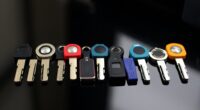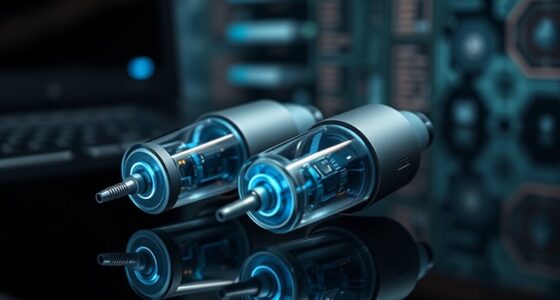If you’re looking for the best 3D printers for students and hobbyists in 2025, I recommend models that combine ease of use, affordability, and creative potential. From compact, WiFi-enabled printers like Tina2S to beginner-friendly options like the Mini 3D Printer and versatile Creality Ender 3, there’s something to fit every need. Higher-end choices like resin and multi-color printers enhance your projects. Keep exploring these options to find the perfect fit for your creative journey.
Key Takeaways
- Entry-level 3D printers like Tina2S, Mini 3D Printer, and Ender 3 offer affordability, ease of use, and reliable features for beginners and students.
- Features such as auto-leveling, WiFi cloud printing, and multi-color options enhance creative project capabilities.
- Compact, portable models with smaller build volumes are ideal for limited spaces in classrooms, dorms, and home workshops.
- Compatibility with popular filaments (PLA, TPU) and user-friendly software make these printers accessible for learning and experimentation.
- Budget-friendly choices between $150-$500 provide reliable performance, upgrade potential, and support for educational and hobbyist exploration.
Tina2S 3D Printer with WiFi Cloud Printing
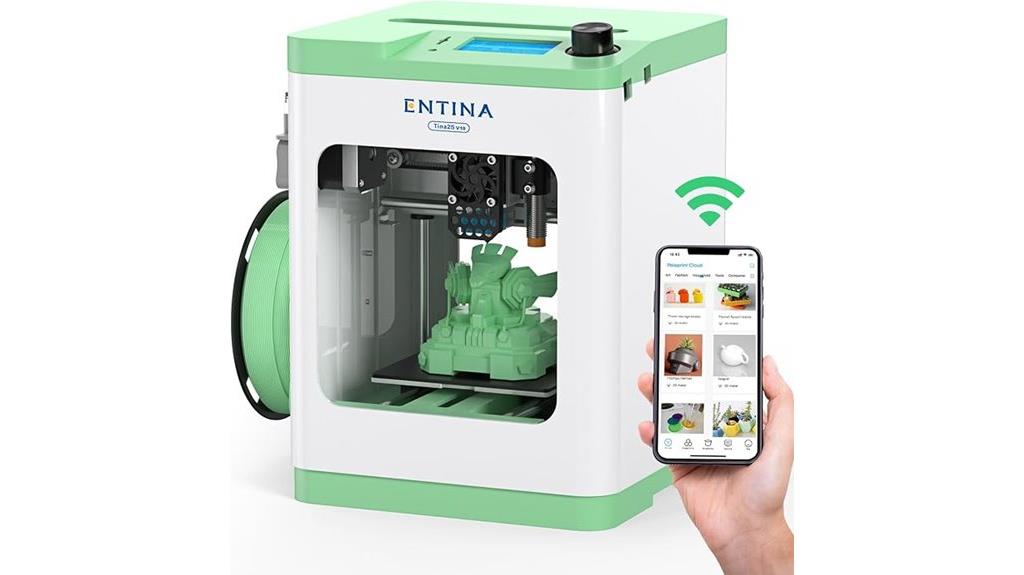
If you’re a student, hobbyist, or beginner looking for an easy-to-use 3D printer, the Tina2S with WiFi cloud printing is an excellent choice. Its compact, fully assembled design makes setup simple, even for newcomers. The WiFi feature allows quick file transfers and remote control via the app, saving time and hassle. With auto-leveling, a flexible removable build plate, and high precision (0.04mm), it delivers consistent, quality prints. The user-friendly interface, compatibility with popular slicing software, and quiet operation mean you can focus on creating. Overall, Tina2S offers a practical, affordable entry point into 3D printing for learners and enthusiasts alike.
Best For: beginners, students, and hobbyists seeking an easy-to-use, affordable 3D printer with remote control capabilities.
Pros:
- User-friendly setup and operation, ideal for newcomers
- Compact, fully assembled design saves time on assembly
- WiFi cloud printing enables quick file transfer and remote monitoring
Cons:
- Limited build volume (~10cm³), suitable mainly for small projects
- Non-heated bed may cause warping with certain filaments
- Occasional issues with filament feeding and microSD card read errors
Mini 3D Printer for Beginners with 8 Colors PLA Filament
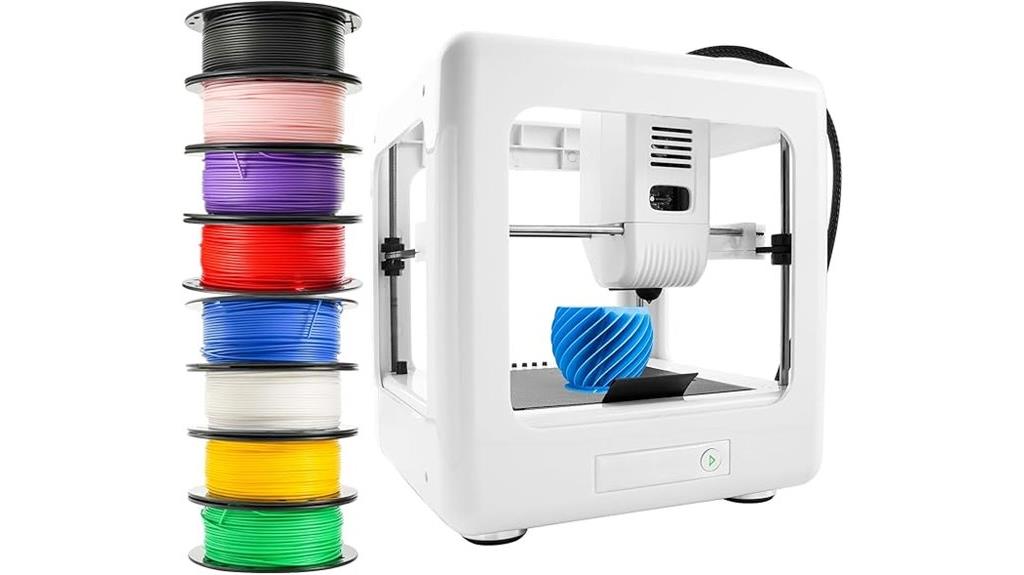
The Mini 3D Printer with 8-color PLA filament is perfect for beginners who want an easy and engaging way to start 3D printing, whether they’re kids, teens, or adults. It comes with an all-in-one starter kit featuring vibrant PLA filaments, user-friendly instructions, and no complicated calibration. Its compact, lightweight design makes it ideal for small spaces like desks or classrooms. Setup is simple—just plug in and start printing. Supporting USB and TF card connections, it’s compatible with Windows and macOS. With a nozzle supporting detailed prints at 0.05-0.2mm accuracy, it’s perfect for creative projects and learning.
Best For: beginners of all ages—including kids, teens, and adults—who want an easy-to-use 3D printer with a variety of vibrant filament options for creative projects.
Pros:
- User-friendly setup with no complex calibration required
- Compact and portable design ideal for small spaces and on-the-go use
- Supports multiple connection types (USB and TF card) and compatible with Windows and macOS
Cons:
- Limited print size due to its small, desktop design
- May require external slicing software for more advanced features
- Printing with multiple colors may need manual filament switching during the process
Official Creality Ender 3 3D Printer

Designed with affordability and ease of use in mind, the Creality Ender 3 stands out as an excellent choice for students and hobbyists new to 3D printing. It offers a sizable build volume of 8.66×8.66×9.84 inches and supports various filament types like PLA. The printer requires about two hours to assemble, and with online tutorials, calibration becomes straightforward. Its open-source design allows for upgrades and customization, while features like a heated bed and upgraded extruder ensure reliable, high-quality prints. Although some re-leveling may be needed, users praise its affordability, community support, and impressive performance for the price point under $200.
Best For: beginners, students, and hobbyists seeking an affordable, reliable 3D printer with a large build volume and extensive community support.
Pros:
- Affordable price point under $200 making it accessible for newcomers
- Open-source design allows for extensive customization and upgrades
- Supports multiple filament types like PLA, with reliable heated bed and straightforward assembly
Cons:
- Requires manual bed leveling and occasional re-calibration
- Assembly can be time-consuming and may seem overwhelming for complete beginners
- Limited to SD card and computer connection, with no direct phone printing capability
Creality Resin 3D Printer for Kids and Beginners

For kids and beginners interested in exploring 3D printing, the Creality HALOT R6 stands out with its user-friendly design and high-precision resin printing capabilities. Its compact, lightweight build makes it easy to handle and set up, while the 2K LCD screen ensures sharp, detailed models. The built-in boot guide simplifies the process, and remote monitoring adds convenience. Safety features like splash guards are essential given resin’s chemical risks, and the software offers straightforward operation. Praised for ease of use and quality results, the HALOT R6 is a reliable choice for newcomers enthusiastic to create intricate, professional-looking models without a steep learning curve.
Best For: Kids and beginners seeking an easy-to-use, high-precision resin 3D printer for creative projects and learning.
Pros:
- User-friendly design with built-in guides and simple workflow perfect for novices
- Compact, lightweight build for easy handling and setup
- High-precision 2K LCD screen ensures detailed, smooth models
Cons:
- Resin printing involves chemicals requiring safety precautions and proper ventilation
- Basic slicer software may have limited advanced customization options
- Requires additional accessories like gloves and curing boxes for post-processing
FLASHFORGE AD5X Multi-Color 3D Printer
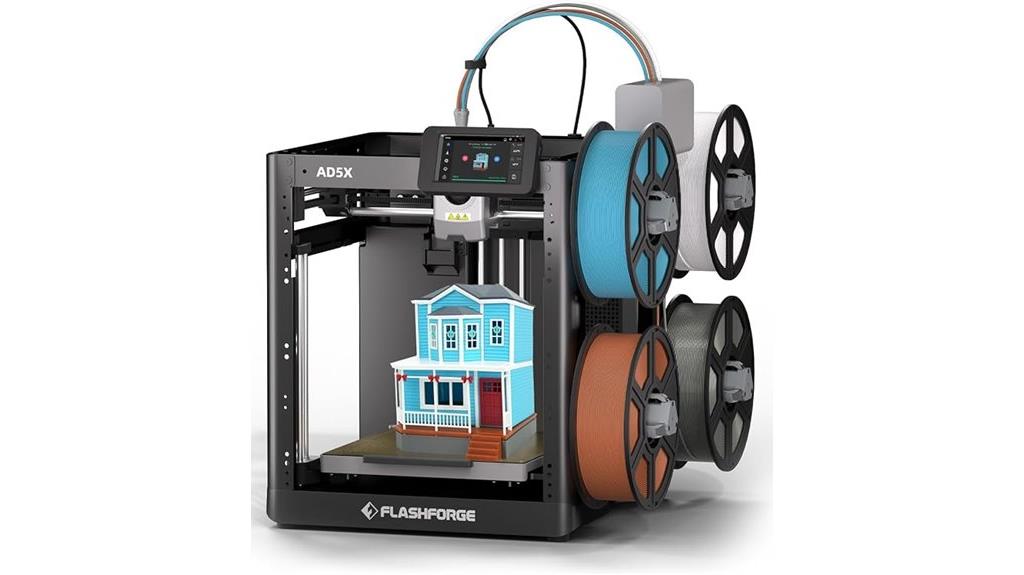
If you’re passionate about creating vibrant, detailed models, the FLASHFORGE AD5X Multi-Color 3D Printer stands out as an excellent choice. Its advanced multi-color printing supports up to four colors at once, allowing for intricate, eye-catching designs. The intelligent filament management system automatically detects and refills filament, minimizing interruptions. With speeds up to 600mm/s and high precision, it delivers fast, accurate results. The all-metal Core XY structure provides stability for complex projects, while the large build volume of 220 x 220 x 220mm and support for flexible materials like TPU make it versatile for various creative needs.
Best For: hobbyists, artists, and professionals seeking vibrant, multi-color 3D prints with high speed and precision.
Pros:
- Supports up to four colors simultaneously for intricate, colorful designs
- Intelligent filament management reduces downtime and simplifies operation
- High-speed printing up to 600mm/s with precise, stable results
Cons:
- Large build volume may require substantial workspace setup
- Multi-color printing can be complex to calibrate for beginners
- All-metal structure might be heavier and less portable
Fully Assembled Mini 3D Printer for Kids and Beginners

A fully assembled mini 3D printer makes it easy for kids and beginners to start printing right away, without the hassle of assembly or calibration. It arrives ready to use, with a compact size of just 8.3” x 8.3” x 11.4”, perfect for home, classroom, or dorm setups. The kit includes 10 meters of PLA filament, a pre-installed microSD card with models and software, and essential accessories. Its reliable design features auto-leveling, a magnetic build plate, and a user-friendly 2.4” LCD screen. WiFi connectivity and compatibility with popular software like Cura and Simplify3D make printing straightforward and fun for newcomers.
Best For: beginners, kids, and educators seeking a reliable, ready-to-use 3D printer for home, classroom, or dorm use.
Pros:
- Fully assembled and ready to print immediately, no assembly required
- Compact and lightweight design ideal for small spaces
- User-friendly features including auto-leveling, magnetic build plate, and LCD screen
Cons:
- Requires specific magnetic metal plates like TINA2S for proper sensor function
- Limited to 1.75mm PLA, PLA pro, and TPU filaments, restricting material options
- May have a learning curve for users unfamiliar with 3D printing software and procedures
Toybox 3D Printer for Kids with Starter Bundle
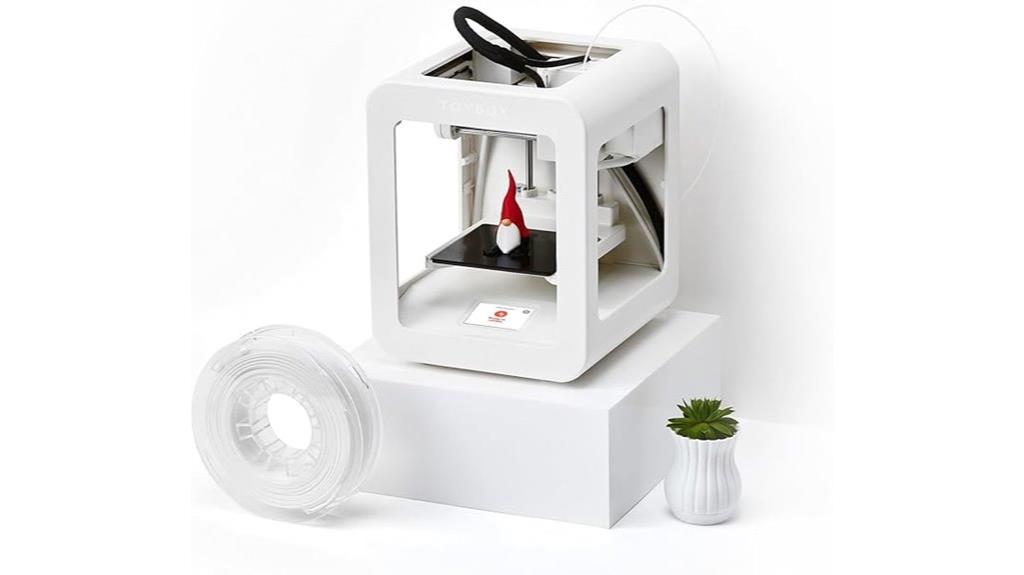
The Toybox 3D Printer Alpha2 stands out as an ideal choice for children and young beginners enthusiastic to explore 3D printing. Its compact size (7.48 x 7.48 x 9.25 inches) and lightweight design (9 pounds) make it perfect for small spaces. With one-touch controls, easy filament loading, and a removable print bed, it’s incredibly user-friendly—many start printing within 10 minutes. Wi-Fi connectivity allows standalone operation, and the cloud-based design library offers thousands of toys and customizable options. While some users report occasional tech issues, overall, it provides a fun, educational experience, fostering creativity for kids as young as 10.
Best For: children and beginner 3D printing enthusiasts aged 10 and above seeking an easy-to-use, educational, and fun introduction to 3D printing.
Pros:
- User-friendly with one-touch controls and quick setup, enabling kids to start printing within 10 minutes
- Compact and lightweight design ideal for small spaces and easy handling
- Extensive cloud-based toy library and customizable options foster creativity and learning
Cons:
- Occasional technical issues and connectivity problems reported by users
- Customer support and warranty services can be slow or unresponsive
- Higher price point with some concerns about build quality and feature limitations
Creality Ender 3 3D Printer with Resume Printing and Stable Power Supply

With its resume printing feature and stable power supply, the Creality Ender 3 is an excellent choice for students and hobbyists who want reliable, high-quality 3D prints without a steep learning curve. It offers a build volume of 8.66 x 8.66 x 9.84 inches and delivers high-resolution output with ±0.1mm accuracy, perfect for detailed models. The heated bed heats quickly, reducing warping, while the upgraded extruder minimizes clogs. Though manual bed leveling is necessary, the active community provides tutorials for auto-leveling mods. Its affordability, ease of assembly, and extensive upgrade options make it a versatile, beginner-friendly printer for prototyping and creative projects.
Best For: hobbyists, students, and beginners seeking a reliable, easy-to-assemble 3D printer with excellent print quality and upgrade options.
Pros:
- High-resolution accuracy of ±0.1mm, suitable for detailed models and prototypes
- Resume printing feature ensures reliable prints after power interruptions
- Extensive community support and upgradeability for customization
Cons:
- Manual bed leveling requires time and effort, which may be challenging for beginners
- Occasional noise from stepper drivers can be distracting, though upgrade options exist
- Initial setup and calibration may involve some trial and error for optimal results
Tina2 Mini 3D Printer for Kids
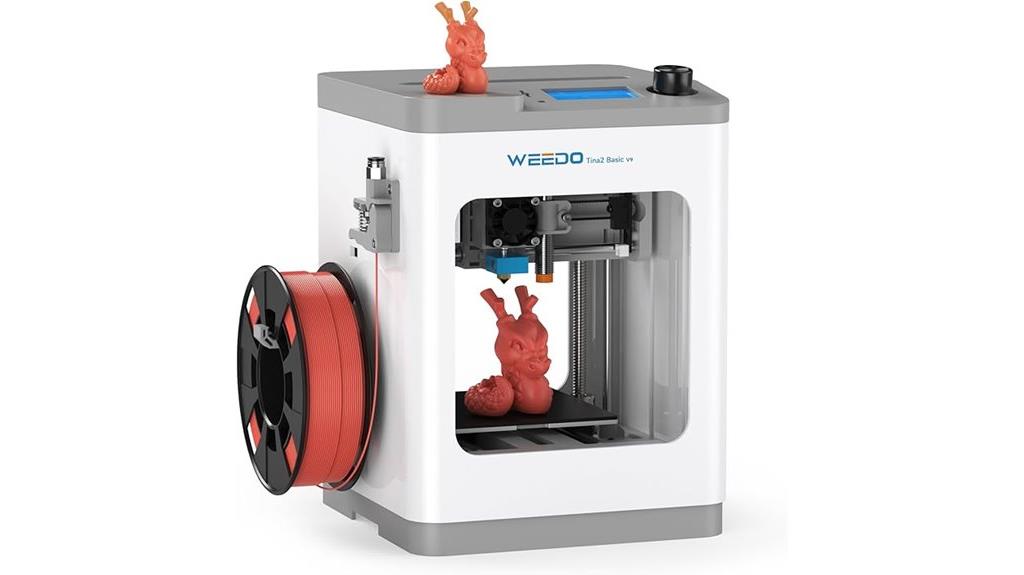
If you’re looking for a 3D printer that’s perfect for beginners and kids, the Tina2 Mini stands out with its fully assembled, plug-and-play design. Weighing just 6.6 pounds, it’s compact and safe, thanks to a semi-enclosed hotend and a flexible platform for easy print removal. It supports multiple filaments like PLA, PLA+, and TPU, making it versatile for various projects. Its auto-leveling feature ensures quick setup, often within 15 minutes, and the intuitive LCD interface guides users step-by-step. Perfect for educational use, Tina2 delivers reliable, high-quality prints and is simple enough for kids aged 12 and up with supervision.
Best For: beginners, kids aged 12 and up, and educators seeking a safe, easy-to-use 3D printer for educational and hobby projects.
Pros:
- Fully assembled and plug-and-play design for quick setup and ease of use
- Auto-leveling feature with proximity sensors for reliable bed calibration without manual adjustments
- Supports multiple filaments like PLA, PLA+, and TPU, offering versatility for various projects
Cons:
- Some users may experience minor troubleshooting with Wi-Fi connectivity and software updates
- Bed adhesion can sometimes require minor adjustments or replacements for optimal results
- Limited build volume for larger models, making it best suited for small projects and educational models
3D Printer for Kids with PLA Filament and Design Modules
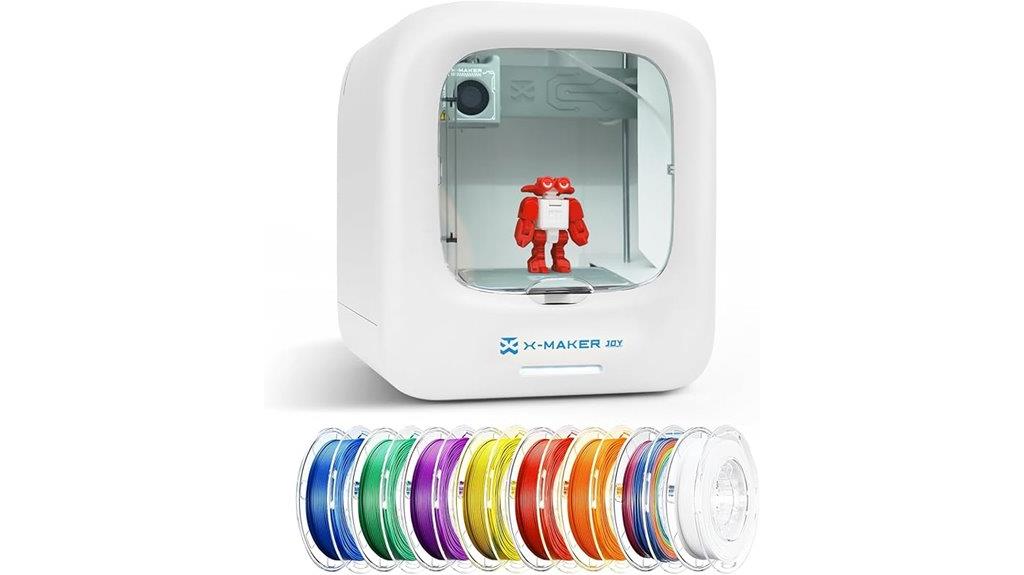
Are you looking for a kid-friendly 3D printer that combines safety, ease of use, and creative flexibility? The AOSEED X-Maker Joy is perfect for young learners. It’s compact, fully enclosed, and designed for home and educational use, with a simple one-click app interface. The printer offers high precision and fast speeds, plus a huge digital library of over 1,500 designs and themed modules to inspire creativity. It supports Wi-Fi and app control, with features like real-time monitoring and voice commands. While it’s ideal for small projects and beginner experimentation, it’s best suited for fun, educational purposes rather than large or complex models.
Best For: parents, educators, and young children seeking a safe, easy-to-use 3D printing experience that fosters creativity and basic design skills at home or in classrooms.
Pros:
- User-friendly with one-click app operation and fully enclosed safety design
- Includes a comprehensive kit with multiple filaments, designs, and educational modules
- Supports Wi-Fi, app control, voice commands, and real-time monitoring for an engaging experience
Cons:
- App can be buggy, slow, and sometimes requires force resets, leading to frustration
- Limited build volume makes it unsuitable for large or complex projects
- Compatibility issues with third-party filaments can cause jams and printing errors
ELEGOO Saturn 3 Ultra MSLA 3D Printer

The ELEGOO Saturn 3 Ultra MSLA 3D Printer stands out as an excellent choice for students and hobbyists who need high-detail models without the complexity of traditional FDM printers. Its 10-inch 12K monochrome LCD delivers crisp, detailed prints with XY resolutions of 19×24μm, while the large build volume of 218.88×122.88×260 mm allows for bigger projects or multiple items at once. The user-friendly calibration system, Wi-Fi connectivity, and stable Linux OS make operation straightforward. Though some customer experiences highlight issues with USB drives and filters, overall, it’s praised for reliability, speed, and impressive detail, making it a top pick for learning and creative projects.
Best For: hobbyists, students, and professionals seeking high-detail resin prints with a large build volume and user-friendly features for creative and educational projects.
Pros:
- Exceptional 12K monochrome LCD for highly detailed and crisp models
- Large build volume suitable for bigger projects or multiple prints simultaneously
- Easy calibration and stable operation via Linux OS with Wi-Fi connectivity
Cons:
- USB thumb drives may experience connection issues and errors
- Some users report inconsistent performance of included air filters
- Customer service experiences can vary, with difficulty reaching support at times
Upgraded Tina2S 3D Printer with WiFi Cloud Printing
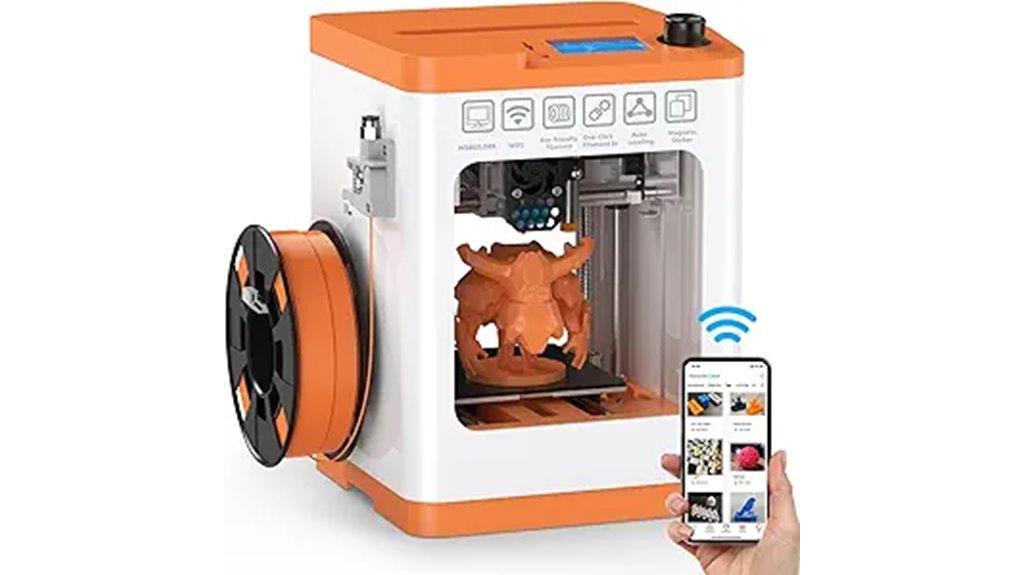
Looking for an easy-to-use 3D printer that combines convenience with affordability? The Upgraded Tina2S by HEPHI3D fits the bill perfectly. It’s a compact, fully assembled printer ideal for beginners, students, and hobbyists. WiFi cloud printing via the Poloprint Cloud app allows remote control with one-click slicing, compatible with popular software like Cura and PrusaSlicer. Features include auto bed leveling, a heated magnetic platform, and quiet operation—perfect for home or classroom use. Its small build volume is great for personalized projects and educational models. Overall, Tina2S offers reliable performance, user-friendly setup, and excellent connectivity, making it a versatile choice for creative learning.
Best For: beginners, students, and hobbyists seeking an affordable, easy-to-use 3D printer with remote connectivity and reliable performance.
Pros:
- User-friendly setup with auto bed leveling and quiet operation
- WiFi cloud printing with remote control via Poloprint Cloud app
- Compact, lightweight design ideal for small projects and educational use
Cons:
- Limited build volume may not suit large or complex models
- Some users experience connectivity issues or unclear instructions
- Software compatibility and initial calibration may require basic troubleshooting
MAYLAN Mini Delta 3D Printer M300

If you’re a student or hobbyist seeking an easy-to-use 3D printer that delivers reliable results, the MAYLAN Mini Delta M300 stands out with its automatic leveling system. This fully assembled, compact printer offers a 110×110 mm build area, perfect for small projects. It comes with a preloaded MicroSD card, sample PLA filament, and supports USB printing from Windows or Mac. The all-metal hotend ensures durability and consistent quality, while the simple UI and sturdy design make setup straightforward. Although some users report calibration tweaks are needed, its user-friendly features and solid performance make it a great choice for beginners enthusiastic to explore 3D printing.
Best For: beginners, students, and hobbyists seeking an easy-to-use, reliable 3D printer for small projects and educational purposes.
Pros:
- Fully assembled and ready to use out of the box, reducing setup time.
- Automatic leveling system simplifies calibration for consistent prints.
- Compact design with a user-friendly interface makes it suitable for home and classroom environments.
Cons:
- Some users report needing to fine-tune slicer settings for optimal adhesion and quality.
- Occasional issues with clogging and adhesion problems after extended use.
- Limited build volume of 110×110 mm may restrict larger project printing.
ELEGOO Mars 4 DLP 3D Printer
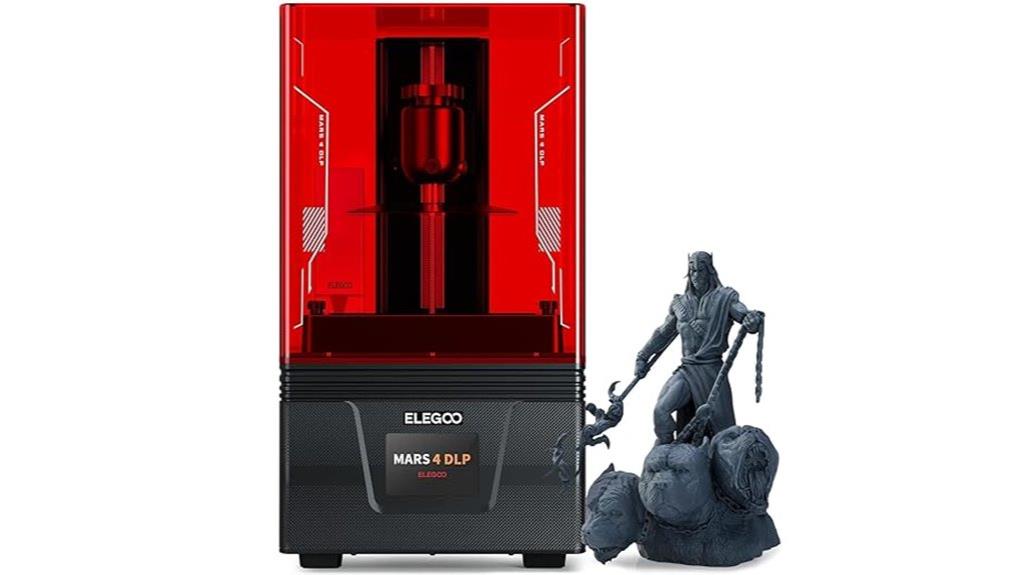
For students and hobbyists seeking high-quality resin prints without breaking the bank, the ELEGOO Mars 4 DLP 3D Printer offers an impressive blend of advanced technology and user-friendly features. It uses TI DLP technology with a 405nm beam for uniform light projection, replacing LCD screens with tempered glass for better light transmittance. Its stable, thickened Z-axis minimizes vibration, ensuring detailed results. The compact size is perfect for miniatures and prototypes. With a lifespan of over 20,000 hours, low power consumption, and quiet operation, it’s reliable and economical. Easy to use and produce high-resolution prints, the Mars 4 is ideal for hobbyists and beginners alike.
Best For: hobbyists, students, and beginners seeking high-quality, reliable resin 3D printing without high costs.
Pros:
- Uses advanced TI DLP technology for high light uniformity and detailed prints
- Long-lasting projector lifespan of over 20,000 hours reduces maintenance
- Compact and easy to operate, ideal for miniatures and prototypes
Cons:
- Potential manufacturing flaws such as bent leadscrews or misaligned parts may affect print quality
- Factory packaging issues can cause damage to screens or components
- Some design choices, like sensor placement and unsupported leadscrews, can complicate maintenance and calibration
FLASHFORGE Adventurer 5M 3D Printer with Auto Leveling

The FLASHFORGE Adventurer 5M stands out as an ideal 3D printer for students and hobbyists thanks to its fully automatic bed leveling, which simplifies setup and guarantees consistent first layers. Its high-speed printing capabilities—up to 600mm/s—allow rapid prototyping and creative exploration. The 280°C direct extruder with a detachable nozzle supports various filament types and sizes, while the coreXY all-metal structure ensures durability and precision. With a 220x220x220mm build volume, rapid warm-up, and real-time remote monitoring via the Flash Maker app, it combines ease of use with impressive performance, making it a versatile choice for learning and experimentation.
Best For: students and hobbyists seeking a reliable, easy-to-use 3D printer with fast setup and high-speed capabilities for creative projects and prototyping.
Pros:
- Fully automatic bed leveling ensures consistent first layers and ease of use
- High-speed printing up to 600mm/s allows for rapid prototyping and efficient production
- Versatile filament support with a 280°C direct extruder and detachable nozzle
Cons:
- Relatively compact build volume of 220x220x220mm may limit larger projects
- Heavier weight of 23.8 pounds could impact portability and placement flexibility
- The initial cost may be higher compared to basic entry-level 3D printers
Factors to Consider When Choosing 3D Printers for Students and Hobbyists
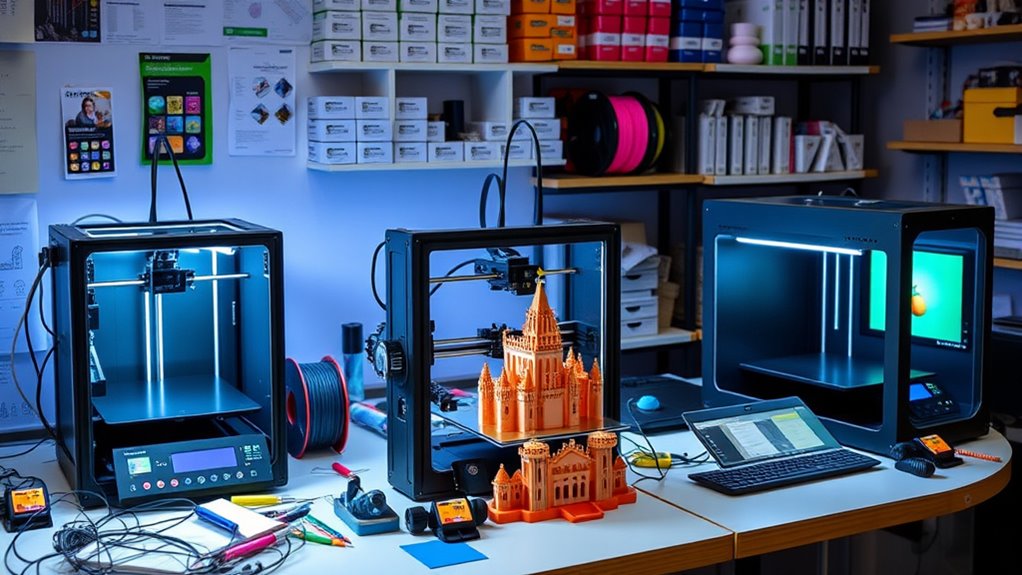
When choosing a 3D printer, I consider factors like your budget and how much you’re willing to spend, since prices can vary widely. Ease of assembly and print size limitations also matter, especially if you’re new or working on larger projects. Additionally, it’s important to verify material compatibility and software usability to make certain your setup fits your skill level and project needs.
Budget and Cost
Choosing the right 3D printer involves carefully considering the total cost of ownership, including not just the initial purchase price but also ongoing expenses like replacement parts, filaments, and maintenance. Entry-level models typically cost between $150 and $500, offering a good balance of affordability and essential features. Higher-priced printers often deliver better print quality, larger build volumes, and more reliable operation, but may be outside a beginner’s budget. Budget constraints can also limit access to advanced features like auto-leveling, multi-material support, or WiFi connectivity, which can impact usability. It’s important to compare the costs of consumables and potential upgrades over time to guarantee the printer remains affordable and suitable for your projects and learning goals.
Ease of Assembly
Selecting a 3D printer that’s easy to assemble can make a big difference in how quickly you start creating. Opt for models that come fully assembled or require minimal setup, so you can jump into your projects sooner. Look for printers with clear, step-by-step instructions or tutorials that guide you through the assembly process easily. Devices with auto-leveling beds and user-friendly interfaces simplify calibration and ongoing maintenance, reducing frustration. It’s also helpful if the printer includes all necessary tools and accessories, so you don’t have to hunt for extra parts. Additionally, consider the weight and size of the printer, making sure it fits your space and physical capacity. An intuitive setup ensures you spend more time designing and printing rather than troubleshooting.
Print Size Limitations
The build volume of a 3D printer directly impacts the size of objects you can create in a single print. If you’re working with miniatures or educational models, smaller build areas around 100mm³ are perfect. However, they limit larger projects, requiring multiple prints or assembly. For bigger prototypes or multi-part designs, printers with larger volumes, like 220x220x250mm, are more suitable. Keep in mind, larger build sizes often mean increased cost and a bigger footprint. Understanding these size constraints helps you choose a printer that matches your project scope. If you frequently need larger models, prioritize printers with bigger volumes. Otherwise, smaller printers can be more affordable and space-efficient for hobbyists focusing on smaller, detailed objects.
Material Compatibility
When evaluating a 3D printer for your projects, it’s vital to confirm it supports the filament materials you plan to use. I check whether it handles common filaments like PLA, ABS, PETG, or flexible options like TPU, and whether it can use resin if I want detailed prints. I also verify the maximum extrusion temperature and heated bed capabilities to guarantee it can handle specialized materials like nylon or composite blends. Matching filament diameter—usually 1.75mm or 2.85mm—is essential for compatibility. Some printers support multiple filament types interchangeably, but others need specific settings for each. I prefer printers with open-source firmware options, so I can customize and experiment with new materials, expanding my creative and learning opportunities.
Software Usability
Choosing the right software can make or break your 3D printing experience, especially if you’re a student or hobbyist just starting out. User-friendly interfaces with intuitive controls and minimal setup are essential, so you can focus on creating rather than fighting with complicated menus. Compatibility with popular slicing programs like Cura, Simplify3D, or open-source options ensures flexible workflows. Features like automatic bed leveling, preloaded models, and one-click printing help reduce the learning curve and technical hurdles. Reliable firmware updates and troubleshooting support within the software boost long-term usability, keeping your printer running smoothly. Additionally, software that offers mobile app compatibility and remote monitoring lets you oversee prints conveniently from your smartphone or tablet, making the entire process more accessible and enjoyable.
Maintenance Requirements
Regular maintenance is essential to keep your 3D printer operating smoothly and producing high-quality prints. I recommend routinely checking bed leveling, cleaning the nozzle, and updating firmware to guarantee peak performance. Some printers need daily or weekly lubrication of moving parts like rails and lead screws to prevent wear and keep operations smooth. Cleaning the print bed and removing residual filament or debris can markedly improve adhesion and reduce failed prints. Monitoring components such as fans, belts, and nozzles, and replacing them when necessary, helps maintain consistent accuracy and prevents breakdowns. Performing routine calibration and troubleshooting software or hardware issues can extend your printer’s lifespan and enhance reliability. Staying on top of these maintenance tasks ensures your printer remains dependable and delivers the best results over time.
Frequently Asked Questions
Which 3D Printer Offers the Best Safety Features for Kids?
I believe the XYZ Junior 3D Printer offers some of the best safety features for kids. It has a fully enclosed design, preventing accidental contact with hot parts, and features auto-shutdown if overheating occurs. Plus, its intuitive touchscreen controls make it easy for kids to operate safely. I’d recommend this model for parents wanting a safe, user-friendly way for children to explore 3D printing responsibly.
How Do Noise Levels Vary Among Beginner-Friendly 3D Printers?
Did you know that noise levels among beginner-friendly 3D printers can range from as low as 50 decibels to over 70 decibels? I’ve found that most entry-level models operate quietly enough for home use, typically around 55-65 decibels, comparable to background conversation. However, some cheaper or older printers can get louder, which might be disruptive. So, if quiet operation matters to you, look for models specifically designed with noise reduction features.
What Is the Average Maintenance Required for These 3D Printers?
On average, these beginner-friendly 3D printers need maintenance about once a month. I regularly check and clean the print bed, lubricate the moving parts, and replace any worn-out nozzles or filament. Keeping everything well-maintained ensures smooth operation and high-quality prints. I also inspect the belts and extruder for any issues. Staying on top of maintenance helps me avoid major problems and extends my printer’s lifespan.
Which Models Provide the Most User-Friendly Interfaces for Beginners?
Think of a 3D printer as a friendly guide on your creative journey. I find models like the Creality Ender 3 V2 and FlashForge Finder especially user-friendly because they feature intuitive touchscreens and simple setup processes. These printers act as your loyal companions, making it easy to learn and experiment without feeling overwhelmed. Their straightforward interfaces help you turn ideas into reality with confidence and ease.
How Do Filament Compatibility and Costs Differ Across These Printers?
Filament compatibility varies across models, with some printers supporting a wide range like PLA, ABS, PETG, and specialty filaments, while others are more limited. Costs also differ; basic filaments like PLA are affordable, but specialty filaments can get pricey. I recommend checking each printer’s specs to confirm it matches your filament needs and budget, as this can substantially impact your overall experience and expenses.
Conclusion
So, which of these 3D printers will spark your creativity and help you learn? Whether you’re just starting out or diving into more advanced projects, there’s a perfect fit for everyone. Remember, the right printer can turn your ideas into reality—are you ready to bring your imagination to life? With these top picks, your 3D printing journey is just getting started, and the possibilities are endless!

